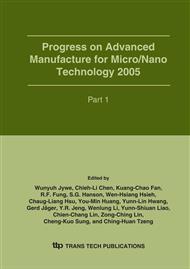p.655
p.661
p.667
p.673
p.679
p.685
p.691
p.697
p.703
Optimization of Parameters Affecting Tool Wear in Titanium Acetabulum Cup Forging
Abstract:
Titanium is an attractive material for orthopedic implants, although it is expensive and difficult to manufacture. Hot forging is usually used, but the tool life is always not good since the forging tools sustain higher temperature and the working pressure induces wear. In this research proposes a procedure to obtain forging parameter design optimization considering tool wear using a combination of FEM simulation and Taguchi method. A modified Archard’s wear model is used to predict the tool wear. This procedure is used to evaluate titanium artificial acetabulum cup forging. Based on the minimum tool wear, but maintaining the microstructure required to satisfy the properties needed by orthopedic implants, the titanium acetabulum cup development is successful and the tool life is better than our expectations.
Info:
Periodical:
Pages:
679-684
Citation:
Online since:
January 2006
Authors:
Keywords:
Price:
Сopyright:
© 2006 Trans Tech Publications Ltd. All Rights Reserved
Share:
Citation:


